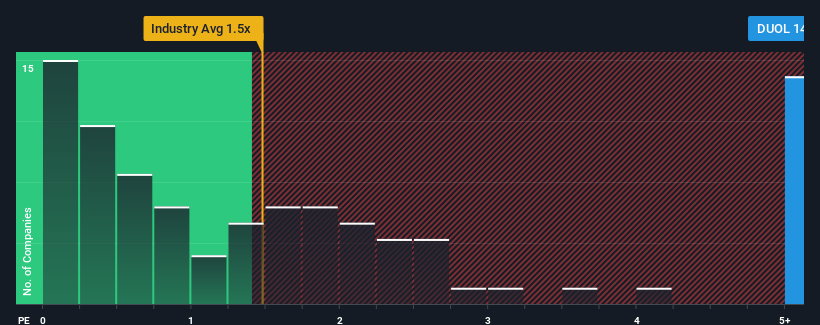- United States
- /
- Consumer Services
- /
- NasdaqGS:DUOL
Duolingo, Inc. (NASDAQ:DUOL) Stocks Shoot Up 31% But Its P/S Still Looks Reasonable

Duolingo, Inc. (NASDAQ:DUOL) shareholders would be excited to see that the share price has had a great month, posting a 31% gain and recovering from prior weakness. The last 30 days bring the annual gain to a very sharp 43%.
After such a large jump in price, you could be forgiven for thinking Duolingo is a stock to steer clear of with a price-to-sales ratios (or "P/S") of 14.6x, considering almost half the companies in the United States' Consumer Services industry have P/S ratios below 1.5x. Nonetheless, we'd need to dig a little deeper to determine if there is a rational basis for the highly elevated P/S.
Check out our latest analysis for Duolingo

What Does Duolingo's Recent Performance Look Like?
With revenue growth that's superior to most other companies of late, Duolingo has been doing relatively well. It seems that many are expecting the strong revenue performance to persist, which has raised the P/S. You'd really hope so, otherwise you're paying a pretty hefty price for no particular reason.
Keen to find out how analysts think Duolingo's future stacks up against the industry? In that case, our free report is a great place to start.How Is Duolingo's Revenue Growth Trending?
Duolingo's P/S ratio would be typical for a company that's expected to deliver very strong growth, and importantly, perform much better than the industry.
If we review the last year of revenue growth, the company posted a terrific increase of 43%. The strong recent performance means it was also able to grow revenue by 205% in total over the last three years. So we can start by confirming that the company has done a great job of growing revenue over that time.
Turning to the outlook, the next year should generate growth of 32% as estimated by the analysts watching the company. With the industry only predicted to deliver 12%, the company is positioned for a stronger revenue result.
With this in mind, it's not hard to understand why Duolingo's P/S is high relative to its industry peers. Apparently shareholders aren't keen to offload something that is potentially eyeing a more prosperous future.
The Final Word
Duolingo's P/S has grown nicely over the last month thanks to a handy boost in the share price. Typically, we'd caution against reading too much into price-to-sales ratios when settling on investment decisions, though it can reveal plenty about what other market participants think about the company.
We've established that Duolingo maintains its high P/S on the strength of its forecasted revenue growth being higher than the the rest of the Consumer Services industry, as expected. It appears that shareholders are confident in the company's future revenues, which is propping up the P/S. Unless these conditions change, they will continue to provide strong support to the share price.
We don't want to rain on the parade too much, but we did also find 2 warning signs for Duolingo that you need to be mindful of.
If strong companies turning a profit tickle your fancy, then you'll want to check out this free list of interesting companies that trade on a low P/E (but have proven they can grow earnings).
New: Manage All Your Stock Portfolios in One Place
We've created the ultimate portfolio companion for stock investors, and it's free.
• Connect an unlimited number of Portfolios and see your total in one currency
• Be alerted to new Warning Signs or Risks via email or mobile
• Track the Fair Value of your stocks
Have feedback on this article? Concerned about the content? Get in touch with us directly. Alternatively, email editorial-team (at) simplywallst.com.
This article by Simply Wall St is general in nature. We provide commentary based on historical data and analyst forecasts only using an unbiased methodology and our articles are not intended to be financial advice. It does not constitute a recommendation to buy or sell any stock, and does not take account of your objectives, or your financial situation. We aim to bring you long-term focused analysis driven by fundamental data. Note that our analysis may not factor in the latest price-sensitive company announcements or qualitative material. Simply Wall St has no position in any stocks mentioned.
About NasdaqGS:DUOL
Duolingo
Operates as a mobile learning platform in the United States, the United Kingdom, and internationally.
Flawless balance sheet with high growth potential.
Similar Companies
Market Insights
Community Narratives



